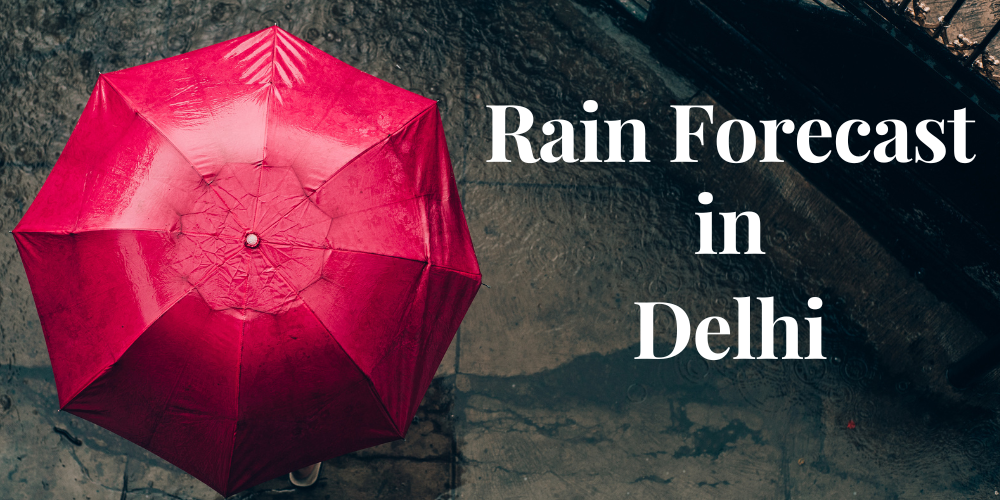
When Will Monsoon Arrive In Delhi?
Residents of Delhi eagerly await the arrival of monsoon every year. The start of monsoon in Delhi usually occurs somewhere in mid-June and can last until mid-August, and has a wide range of factors, such as the intensity of monsoon winds, the temperature of the air, and the presence of atmospheric conditions.
According to India Meteorological Department (IMD) report monsoon is expected around 30 June this year. People in Delhi keep a close eye on these updates and eagerly await the arrival of monsoon, which brings relief from the scorching heat and dust of summer.Average monthly rainfall in New Delhi
New Delhi has a unique climate, experiencing hot summers and mild winters. Every year, the city receives an average of 841 mm of rain over the course of the monsoon season, making it one of India’s wettest regions. But how does this average rainfall vary throughout the year? In this article, we will investigate the monthly rainfall patterns in New Delhi to gain insight into this weather phenomenon.
January
January is one of the coldest months in Delhi, and with that comes a significant amount of rainfall. It is not uncommon for the city to experience a number of rainy days during this time, which can be a challenge for those who are commuting or traveling around the city. However, while it may cause some inconvenience, it is also an important source of water for the region.
According to weather reports, January sees an average rainfall of 22mm in Delhi. This may not sound like much compared to other parts of the world, but it is significant for a city that has limited natural water resources. The rainwater helps replenish water levels in local reservoirs and provides much-needed relief from the dry winter season
February
February is the shortest month of the year, but it often brings a large amount of rainfall in Delhi. The city receives an average of 20mm to 30mm precipitation during this month, which is a significant amount when compared to other months. This rain is also critical for the environment and agriculture as it helps replenish groundwater reserves.
The rainfall during February is mainly due to the western disturbances that bring moisture-laden winds from the Mediterranean region towards India. These winds collide with the Himalayan mountain range and cause heavy rains over northern parts of India, including Delhi. It’s not uncommon for locals to experience sudden downpours or thunderstorms during this time, which can disrupt daily routines and transportation.
March
Rainfall in March is not a new phenomenon in Delhi. As the winter season comes to an end, the chances of rain increase significantly. March marks the beginning of spring in Delhi, and it is a time when people start shedding their winter clothes and prepare for the upcoming summer months. Average rainfall in Delhi in March is around 25mm.
In recent years, however, March has been witness to some unusual weather patterns. The city has experienced an increase in rainfall during this month compared to earlier times. This change can be attributed to various factors such as climate change and global warming. The rise in temperatures across the world has led to changes in weather patterns, causing extreme weather conditions like heavy rainfall or droughts.
April
April is one of the hottest months in Delhi, but it also brings along a sense of relief to its residents as they eagerly wait for the monsoon season. The month of April is significant for its rainfall pattern which helps in cooling down the city’s temperature. Over the years, Delhi has witnessed varying levels of rainfall during this month and it has been both a boon and a bane for its inhabitants.
In recent times, Delhi has experienced erratic weather conditions with unprecedented rainfall patterns leading to flash floods and waterlogging in some areas. As per IMD reports, Delhi recorded around 11 mm rainfall on average in April last year which was lower than the normal level. However, this year expectations are high as monsoon winds have already reached Kerala indicating an early arrival of monsoons over North India including Delhi.
May
Rain in Delhi in May can be a surprise for locals and tourists alike. The capital city of India is known for its scorching heat during the summer months, but May showers bring relief to the sweltering conditions. The monsoon season usually arrives in June, but pre-monsoon showers can be expected as early as May.
The average rainfall in Delhi in May is around 25.4 mm, according to historical weather data. Rain brings respite from the hot weather and improves air quality, making it more pleasant to venture outside. It also rejuvenates the greenery around the city, providing a picturesque backdrop for residents and visitors to enjoy.
June
Rain is a much-awaited event in Delhi as it brings relief from the scorching heat and dust. June marks the arrival of monsoon season in Delhi, and it is known for its heavy downpour. The average rainfall in Delhi in June is around 70.8 mm. The city’s vegetation gets a new lease of life, and the air gets purified by the showers. The pitter-patter sound of raindrops creates an ambiance that fills everyone with joy.
July
July is the month when Delhi experiences monsoon season, bringing much-needed relief from the scorching heat. The average rainfall in Delhi in July is around 165.1 mm. Arrival of rain in Delhi in July brings a sense of joy and freshness to the city. It is a welcome change from the hot and humid weather that has been prevailing for several weeks.
The rain showers tend to cool down the temperature, making it pleasant for people to go outdoors. However, with the rains come heavy traffic, waterlogging on roads, and disrupted public transport services. But despite these inconveniences, most people look forward to enjoying the monsoon season in Delhi every year.
August
Rain in Delhi in August is a common phenomenon. The month of August marks the peak of monsoon season in Delhi and brings along heavy rainfall. The city experiences an average rainfall of around 200-250 mm during the month, which makes it one of the wettest months of the year.
Rain in Delhi adds to the beauty of the city with lush green surroundings and pleasant climate. It makes for a perfect time to enjoy hot chai and pakoras while watching the downpour from your balcony or terrace.
September
September marks the end of monsoon season in Delhi, with an average rainfall of around 129.8 mm according to historical weather data. The temperature during this month ranges from 25°C to 35°C, with occasional thunderstorms and heavy rains.
If you plan on visiting Delhi in September, it’s important to carry appropriate rain gear such as umbrellas or raincoats. Also be prepared for potential delays due to traffic congestion caused by the rains.
October
October is a pleasant month in Delhi, but it also brings along the much-needed rain that the city craves for. With the end of the monsoon season in September, Delhiites eagerly await the arrival of October as it marks the beginning of cooler weather and occasional rainfall. The average rainfall in Delhi in October is around 15.1 mm and the rain showers during this time not only provide relief from the scorching heat but also bring a refreshing change to the surroundings.
November
November is a month of transitions in Delhi. The humid heat of summer gives way to the cooler temperatures of winter, while the city’s parks and gardens turn from lush green to shades of rust and gold. But perhaps one of the most notable changes during this time is the arrival of rain.
While Delhi may not be known for its rainy season, November marks the beginning of a period where precipitation becomes more frequent. The average rainfall in Delhi in November is around 6.1 mm. This can bring much-needed relief from the dryness and pollution that often plagues the city during other times of year.
December
December is one of the most awaited months in Delhi as it brings along a much-needed respite from the scorching heat. However, it also marks the onset of the winter season and with that comes the chilly winds and occasional rainfall. Rain in Delhi during December is a rare occurrence but when it does happen, it can be a welcome break from the otherwise dry weather.
The average rainfall in Delhi during December ranges between 5 mm to 15 mm. The city usually experiences light drizzles which are not heavy enough to cause any inconvenience or disruption in daily life.
Table of Contents

Best Cafes in Delhi for Every Mood and Budget
If you’re looking for the best cafes in Delhi, you’re in for a treat. From hidden gems in quiet corners to lively spots with rooftop

Best Hotels in Delhi NCR for Every Budget
Looking for good hotels in Delhi NCR? Whether you’re visiting for business or a short trip, the region has a wide range of accommodations. From

Places to Visit in New Delhi: A Complete Travel Guide
New Delhi, the vibrant capital of India, is a city that blends history, culture, and modernity. From iconic landmarks to lush gardens and fascinating museums,
